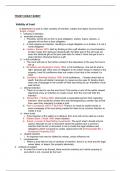Summary
Summary Equity and Trusts problem question outline
- Course
- Institution
This is a thorough outline of all the examinable problem question topics in trust law. There is a detailed outline of how to approach problem questions on each topic; the correct steps to take, the appropriate way to analyse the cases, and the possible remedies. It starts with the three certainties...
[Show more]



